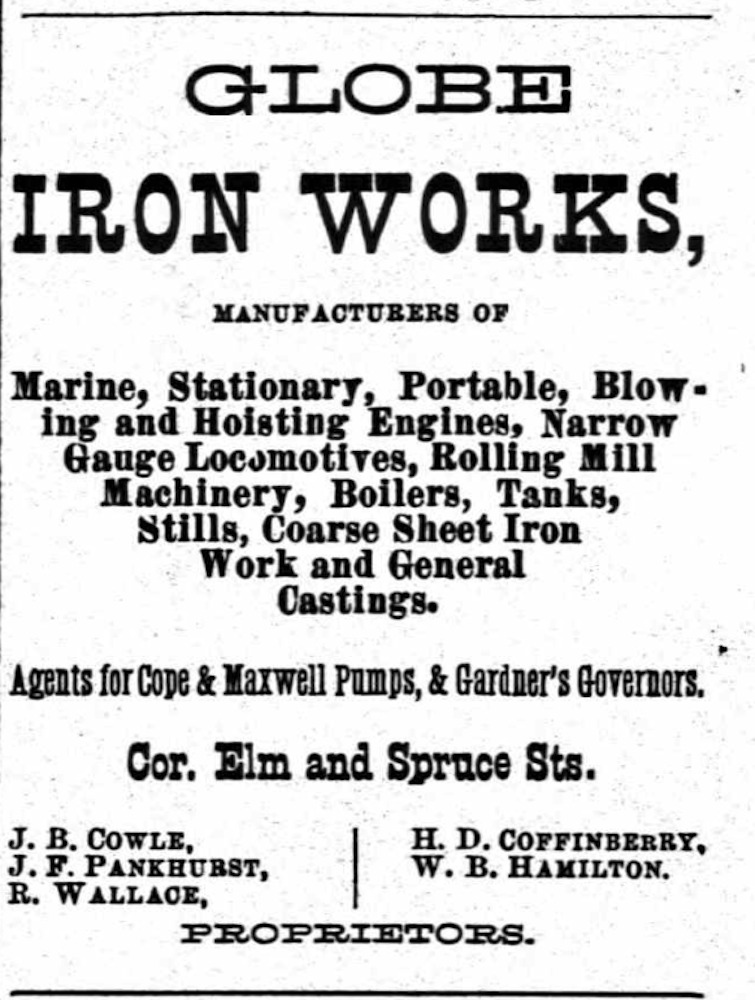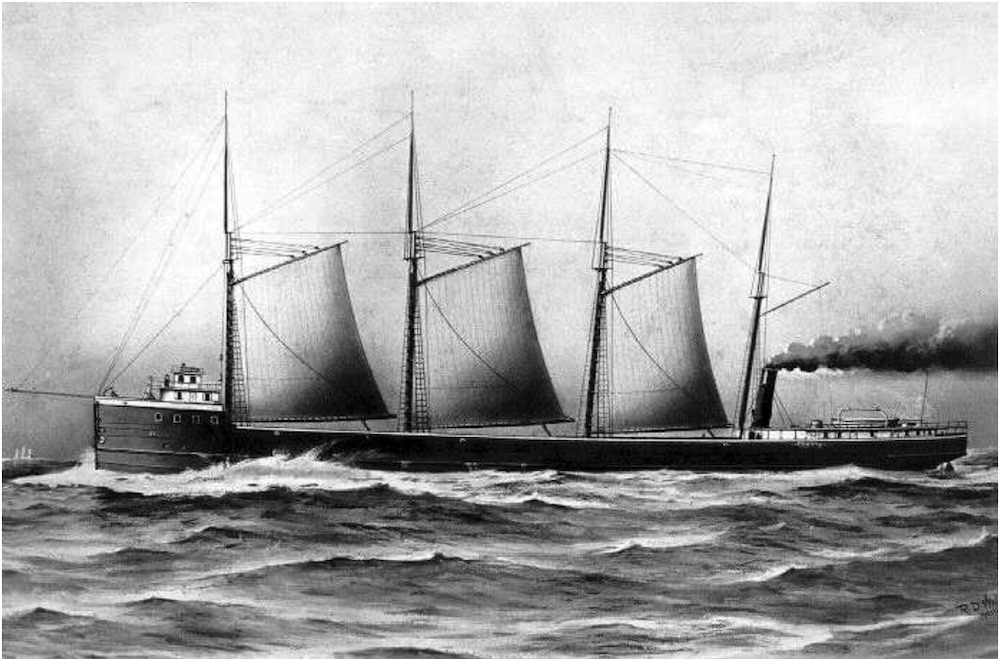
The house at 3910 Franklin Boulevard, which today is largely hidden from view by its owner's lush and exotic landscaping, is known as the Henry Coffinberry House. It was built for Henry Darling Coffinberry, one of Cleveland's shipbuilding industry giants of the late nineteenth century. Along with partners Robert Wallace and John F. Pankhurst, he was instrumental in modernizing the Great Lakes shipbuilding industry and building both the first iron and the first steel large commercial freighters to sail on the Great Lakes. His efforts made Cleveland, for a time, the largest shipbuilding center in the United States. Think of Henry Coffinberry the next time you see an ore carrier streaming across Lake Erie.
Henry Darling Coffinberry was born in Maumee, Ohio, on October 12, 1841. In 1855, when he was 14 years old, his father James, a lawyer who later became a Common Pleas Court judge, moved the family to Cleveland, purchasing a house on Franklin Boulevard that was located on the present day site of the former West Side Masonic Temple building. According to biographers, Henry attended classes at and graduated from West High School, although records from the school do not show him graduating. In 1862, with the Civil War raging, Henry joined the United States Navy, reaching the rank of "Acting Master" and serving until shortly after the War's end in 1865. Returning to Cleveland, he tried his hand at several jobs before buying an interest in a small machine shop owned by fellow west siders Robert Wallace, John Pankhurst and a third individual, Arthur Sawtell, who soon departed from the business. In 1869, the three surviving partners purchased a controlling interest in Globe Iron Works, an iron foundry started in 1853 by a partnership that included Samuel Lord, the brother of Ohio City pioneer real estate developer and mayor Richard Lord. The original foundry was located in the West Bank of the Flats at the northwest corner of Elm Street and Spruce Avenue--no more than a mile or so away from where Henry lived on Franklin Boulevard. After the foundry was destroyed in a fire in January 1872, Henry and his partners built a new foundry--still standing today--on the southwest corner of that intersection.
Henry Coffinberry was living at his parents house in 1869 when he and his partners acquired their interest in Globe Iron Works. He continued to reside with his parents until 1875, the year he married Harriet Morgan, the daughter of Civil War General George W. Morgan. In August 1874, just eight months before his wedding, Coffinberry purchased a house up the street on the north side of Franklin Avenue, several lots west of Kentucky (West 38th) Street. According to local architectural historian Craig Bobby, Coffinberry either razed or moved that house and, in 1875, built in its place the house that today stands at 3910 Franklin Boulevard. Designed in the Gothic Revival style with cross gables, the two-story house has a prominent central gable that has an extension at what had been the original center of the front facade, which incorporates a vestibule and a large, decorative gable above. Two second-floor windows have Gothic detailing and its gables have decorated vergeboards. There is a one story entry porch at its front door. The house also has an addition that was constructed onto its east side in 1895. The addition has a front door which for many years also had an entry porch. Local historian Bobby observed that the house was built in the later years of the Gothic Revival period here in the United States. As a result, it has some features that were influenced by the then more prevalent Italianate style, such as, for example, the elaborate hoods over some of its windows.
According to Cleveland directories, Henry and Harriet Coffinberry did not move into their new house until more than a year after their marriage--sometime in late 1876 or early 1877. (This may have been because they lived with Henry parents during the first year of their marriage, possibly to help care for the latter who had suffered severe injuries in a collision between their carriage and a train near the Union Depot Station while returning home from their son's wedding.) Henry and Harriet, along with their daughters Nadine and Maria, resided in the house at 3910 Franklin until 1891, when the family moved from the house. The fifteen or so years during which Henry Coffinberry lived there corresponded with the most productive years of his business career. In 1876, Globe Iron Works started a new business called Globe Ship Building Company and began producing wooden ships. Henry Coffinberry was tapped by the partners to serve as president of the new business. Five years later in 1881, under his direction, the company built the Onoko, which, when launched in February 1882, became the first large commercial ship built of iron to sail the Great Lakes. By 1883, Globe had built a large shipyard on W. Old River Street (Division Avenue) near its intersection with St. Paul (West 49th) Street, not far from the west end of the Ship Canal. In 1886, the company built and launched at its shipyard the Spokane, the first steel freighter to sail the Great Lakes. Globe Iron's iron and steel ships were prototypes for all the modern freighters that sail the Great Lakes today.
Just a month after the launch of the Spokane in 1886, a dispute within the partnership led to Coffinberry and Wallace's departure from Globe Iron Works and, several months later, their formation of a new company – Cleveland Shipbuilding Co. – which was financially backed by a number of prominent east and west side industrialists, including J. H. Wade, Jr., William Chisolm, M. A. Bradley, Robert Russell Rhodes, and George Warmington. As he had at Globe Ship Building, Coffinberry headed the new company as its president. Cleveland Shipbuilding successfully competed with Globe Ship Building, with both businesses contributing to make Cleveland the leading shipbuilding center in the United States by 1890. Coffinberry retired from the shipbuilding business in 1894. Five years later in 1899, Cleveland Shipbuilding, Globe Iron Works, Ship Owners' Dry Dock Company, and several out-of-town businesses consolidated to form the American Shipbuilding Company, one of Cleveland's great industrial enterprises of the late nineteenth and early twentieth century, according to environmental historian David Stradling and his brother Richard Stradling in their book "Where the River Burned."
After moving out of the house at 3910 Franklin Boulevard in 1891, the Coffinberry family continued to own it and leased it to renters. As noted above, they constructed an addition onto the house in 1895 and converted it into a two-family residence, which, after 1905, had the addresses of 3910 and 3912 Franklin Boulevard. The house remained in the Coffinberry family until 1918 when it was sold by Henry Coffinberry's widow and daughters. The Coffinberry House thereafter passed through the hands of several short-term owners before it was acquired by Ernest and Mary Toth in 1926. Ernest, a carpenter by trade, and his wife Mary, were Hungarian immigrants, as were many residents of Franklin Boulevard during this period. The Toths initially leased it to renters, but from the mid 1930s until the mid 1950s they lived in the east side of the house, renting out only the west side. Photographs of the house taken while it was occupied by the Toth family show that it was well-maintained during this period. The Toths moved to the suburbs in the mid-1950s, and thereafter leased both sides of the Coffinberry House to renters. Mary Toth sold the house in 1963 shortly after the death of her husband. In the several decades that followed, the condition of the house declined until 1982 when it was acquired by Mark Pokrandt who restored and renovated the house. As of 2021, the Henry Coffinberry House is still owned by Pokrandt.
Images














